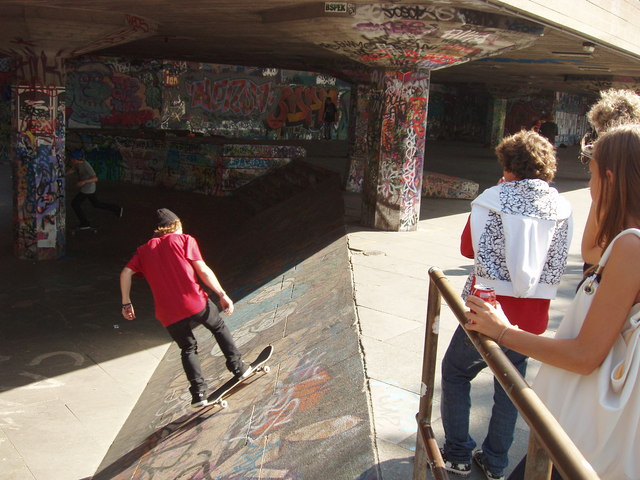Post
ARCHIVE | The Skate Escape | The Southbank Undercroft
26 May 2020
From the London Society Journal 471 (Spring/Summer 2017). The fight to save the much-loved Southbank Centre undercroft as an informal, but internationally famous, skatepark raised impassioned support from unlikely quarters. But, explains Jack Layton, when it comes to use of public space, democracy is never straightforward.
On 1 March, Southbank Centre’s Queen Elizabeth Hall (QEH) celebrated its 50 birthday: 50 years of classical music and public exhibitions on the South Bank. Taken with the National Theatre (1976), and BFI Southbank (1951, formerly the National Film Theatre), this stretch of river has long been the centre of public art and culture in London. It also has some of the best-used public space in the city. However the story of the South Bank has not been unproblematic.
In 2013, plans emerged for extensions to be made to the Southbank Centre. The ambitious project by Feilden Clegg Bradley Studios, the Festival Wing, was to refurbish existing facilities, re-landscape external spaces, and construct a set of new buildings; providing new space for rehearsals, performance, gardening, education, and entertaining. But there was a catch.
To fund the £120 million project a combination of public funding, bank loans, and fundraising was required. To secure leverage against the bank loan, the Southbank Centre planned to introduce commercial units on the riverfront beneath the QEH. Or, as it is more popularly known, the Undercroft .
The Undercroft is the open space that sits beneath the QEH. An assemblage of concrete banks, stairs, and grind-able blocks – it is famous in the skate community. The QEH was originally designed by the architects’ department at London County Council (later Greater London Council), led by Sir Hubert Bennett, Norman Engleback, and Jack Whittle, also involved were Ron Herron, Warren Chalk, and Dennis Crompton who belonged to radical design group Archigram. Their design philosophy led to the space beneath QEH being intentionally left open. The skateboarders made a home there in the 1970s, utilising this modernist flourish to practice their craft. The Undercroft is probably the world’s oldest continually skated space.
When the plans for the Festival Wing emerged, the skateboarders quickly organised and formed Long Live Southbank (LLSB) to protest against the plans and preserve their space. is sparked one of the most heated conflicts in London planning in recent memory.
The Southbank Centre was caught in a difficult position. It was struggling to manage the breadth of the competing stakeholders with an interest in the site. During the consultation process, it had spoken with: professional musicians, arts and cultural organisations, heritage groups, political representatives, local residents, Southbank Centre members, the general public, as well as users of the Undercroft . Moreover it pledged £1million for a new skateable space beneath the Hungerford Bridge (120m upriver), engaging with influential figures within the skate community – an unprecedented move by an arts organisation. But LLSB persisted.
LLSB organised a series of demonstrations and promotional films, raising awareness about their campaign and the importance of the Undercroft as a heritage site. It also broke the record for the number of objections made against a planning application, twice.
On 15th January 2014, then Mayor Boris Johnson intervened in the conflict, telling a preliminary planning meeting that the plans could not go ahead ‘at the detriment of the skate park’. Recognising that the Mayor would have the final say in the planning decision, the Southbank Centre withheld its planning application in February 2014. The Undercroft was saved.
In September of 2014, a resolution was reached as LLSB and Southbank Centre released a joint statement announcing the future security of the site. This agreement required a long process of reconciliation and accommodation. However a er a hard-fought campaign the users of the Undercroft had firmly claimed themselves to be powerful stakeholders on the South Bank.
LLSB and the Southbank Centre are now on happier terms. There are even negotiations over plans to expand the Undercroft skateable space backwards beneath QEH, bringing it more in line with how the space was originally conceived. LLSB would just need to raise £400,000 to fund the project.
This piece of recent history underscores the challenge of how to manage the public spaces of the city. On the one hand the expansion to the Southbank Centre would have been well used, continuing their tradition of stimulating public work; on the other there is no doubt that the skateboarders made a compelling case for their corner of the site to be preserved. Democracy, especially in a planning context, is rarely straightforward. Communication, a shared sense of community, and compromise are necessary elements for a responsive and responsible planning process.
Jack Layton is a geography PhD candidate at UCL. His research focuses on urban public space.
FIND OUT MORE: The Undercroft on film Long Live Southbank: the Bigger Picture 40 year history and the nine-month campaign to protect it Available on youtube.com
You Can't Move History – But You Can Secure the Future The Undercroft community’s individual and collective attachments to the space Available on youtube.com
More info on everything LLSB, including their fundraising campaign
